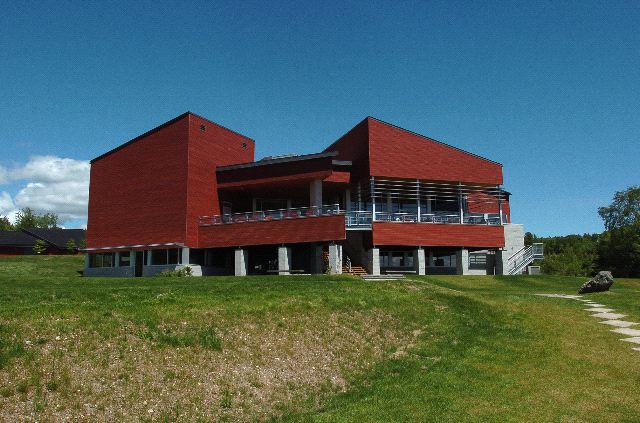The on-site museum
Very few large fossil sites around the world are privileged enough to have an on-site museum, which specialists call an in situ museum.
 (44 kb) The Natural History Museum of the Parc national de Miguasha belongs in this category. An on-site museum creates very close ties between the various components of the museum, including research, preservation and display.
(44 kb) The Natural History Museum of the Parc national de Miguasha belongs in this category. An on-site museum creates very close ties between the various components of the museum, including research, preservation and display.
At Miguasha, fossil excavation takes place only a short distance away from the fossil identification and preparation laboratories, and to the rooms that house the collections.
 (64 kb)This proximity greatly facilitates the simultaneous management of the fossils and the museum’s collections. Similarly, on-site research constantly enriches and improves the museum’s education program.
(64 kb)This proximity greatly facilitates the simultaneous management of the fossils and the museum’s collections. Similarly, on-site research constantly enriches and improves the museum’s education program.
Visitors of all ages come to see the museum’s permanent exhibition hall, which is dedicated to Miguasha’s rich fossil heritage. And for the past thirty years, the guided tour has also included a visit the fossil site. Of course, this access is for educational purposes only, and the park’s rule prohibiting fossil collecting by visitors is respected.

 (48 kb)Another example of an on-site museum at a Canadian fossil site is that of the recently opened natural history museum at Joggins, Nova Scotia. Joggins is representative of the Carboniferous Period – the geological period following the Devonian – appropriately known as the Age of Coal. The Joggins authorities are currently trying to get the site accepted onto the UNESCO World Heritage List.
(48 kb)Another example of an on-site museum at a Canadian fossil site is that of the recently opened natural history museum at Joggins, Nova Scotia. Joggins is representative of the Carboniferous Period – the geological period following the Devonian – appropriately known as the Age of Coal. The Joggins authorities are currently trying to get the site accepted onto the UNESCO World Heritage List.

 (44 kb) The Natural History Museum of the Parc national de Miguasha belongs in this category. An on-site museum creates very close ties between the various components of the museum, including research, preservation and display.
(44 kb) The Natural History Museum of the Parc national de Miguasha belongs in this category. An on-site museum creates very close ties between the various components of the museum, including research, preservation and display. At Miguasha, fossil excavation takes place only a short distance away from the fossil identification and preparation laboratories, and to the rooms that house the collections.

 (64 kb)This proximity greatly facilitates the simultaneous management of the fossils and the museum’s collections. Similarly, on-site research constantly enriches and improves the museum’s education program.
(64 kb)This proximity greatly facilitates the simultaneous management of the fossils and the museum’s collections. Similarly, on-site research constantly enriches and improves the museum’s education program.Visitors of all ages come to see the museum’s permanent exhibition hall, which is dedicated to Miguasha’s rich fossil heritage. And for the past thirty years, the guided tour has also included a visit the fossil site. Of course, this access is for educational purposes only, and the park’s rule prohibiting fossil collecting by visitors is respected.

 (48 kb)Another example of an on-site museum at a Canadian fossil site is that of the recently opened natural history museum at Joggins, Nova Scotia. Joggins is representative of the Carboniferous Period – the geological period following the Devonian – appropriately known as the Age of Coal. The Joggins authorities are currently trying to get the site accepted onto the UNESCO World Heritage List.
(48 kb)Another example of an on-site museum at a Canadian fossil site is that of the recently opened natural history museum at Joggins, Nova Scotia. Joggins is representative of the Carboniferous Period – the geological period following the Devonian – appropriately known as the Age of Coal. The Joggins authorities are currently trying to get the site accepted onto the UNESCO World Heritage List.Site map | Feedback | Links | Sources | Credits
The on-site museum
<< Fossil digs and research | The Devonian: Age of Fishes >>

Title: The museum in 1991
Author: Parc national de Miguasha
Sources: Parc national de Miguasha
Year: 1991
Description:
The original museum was expanded so that a brand new facility awaited the participants of the 7th International Symposium on the Studies of Lower Vertebrates.




